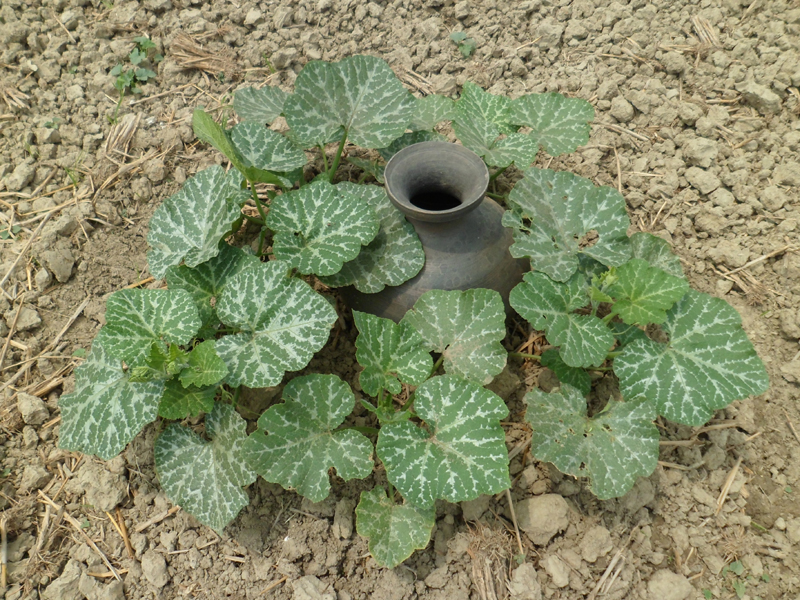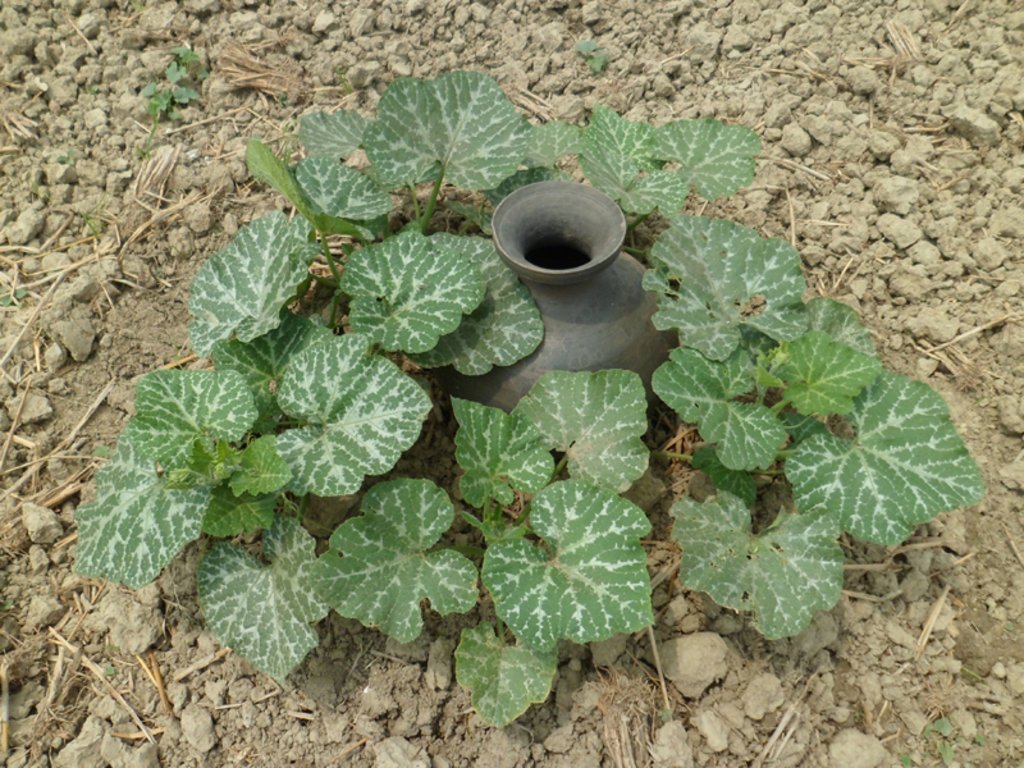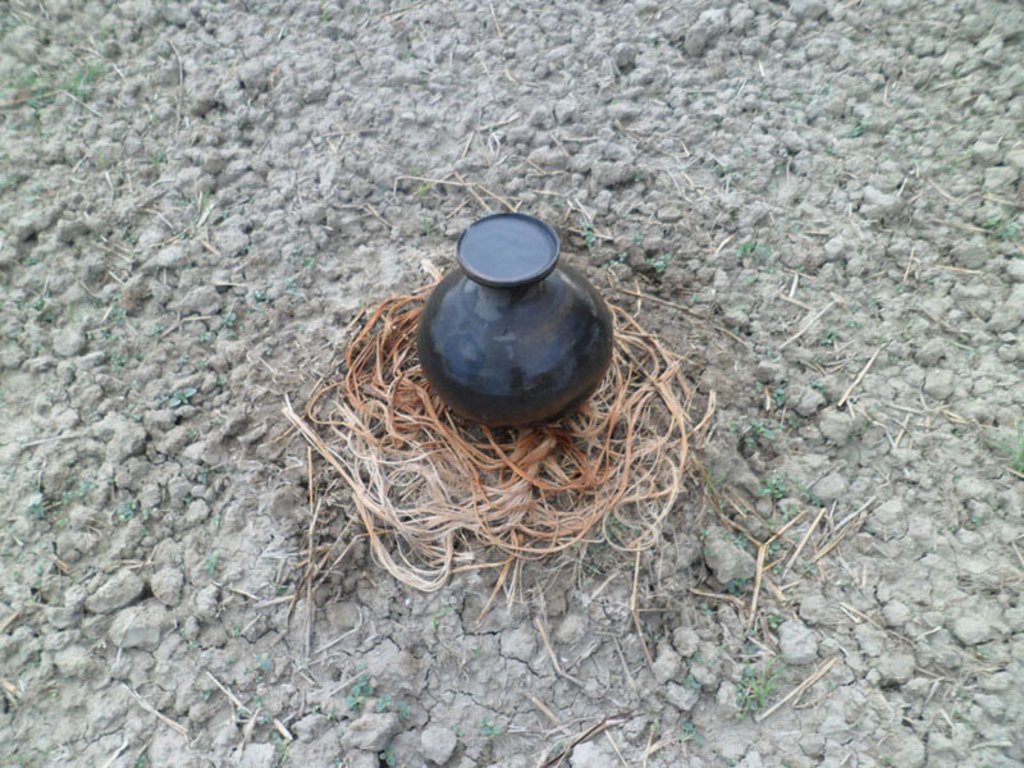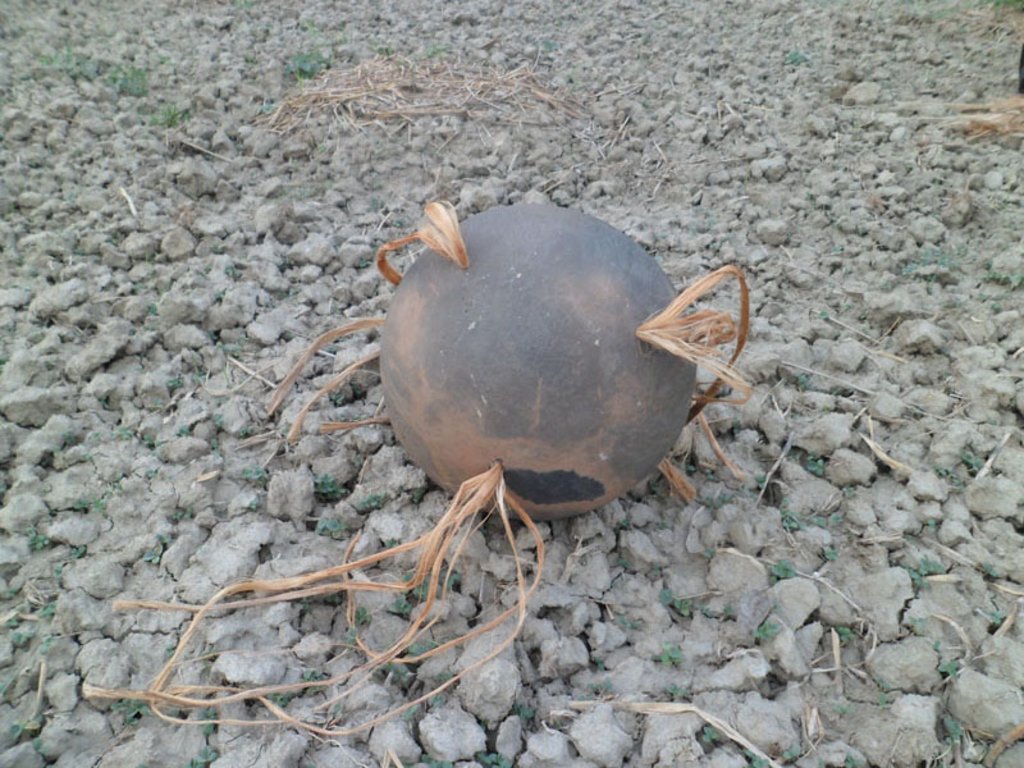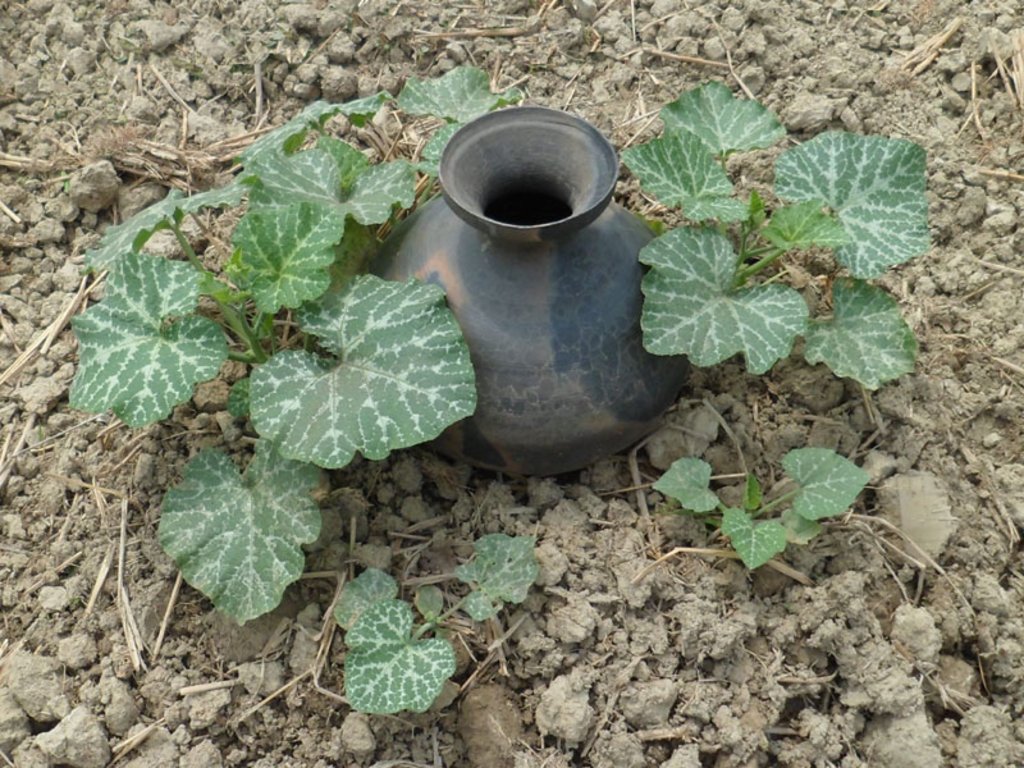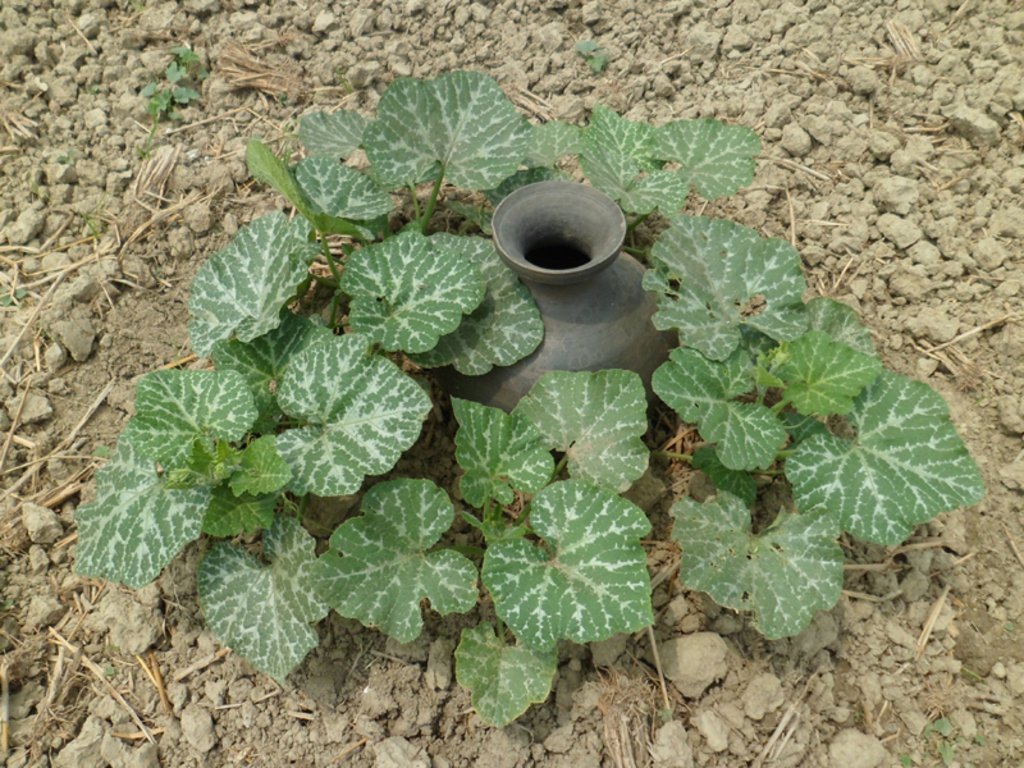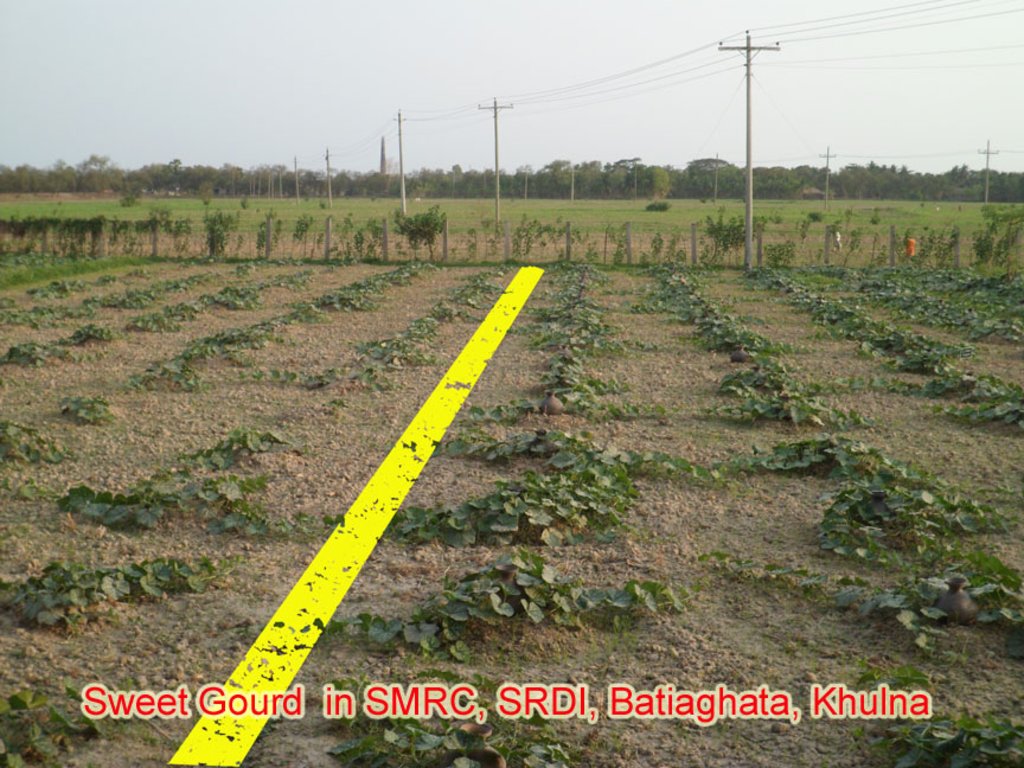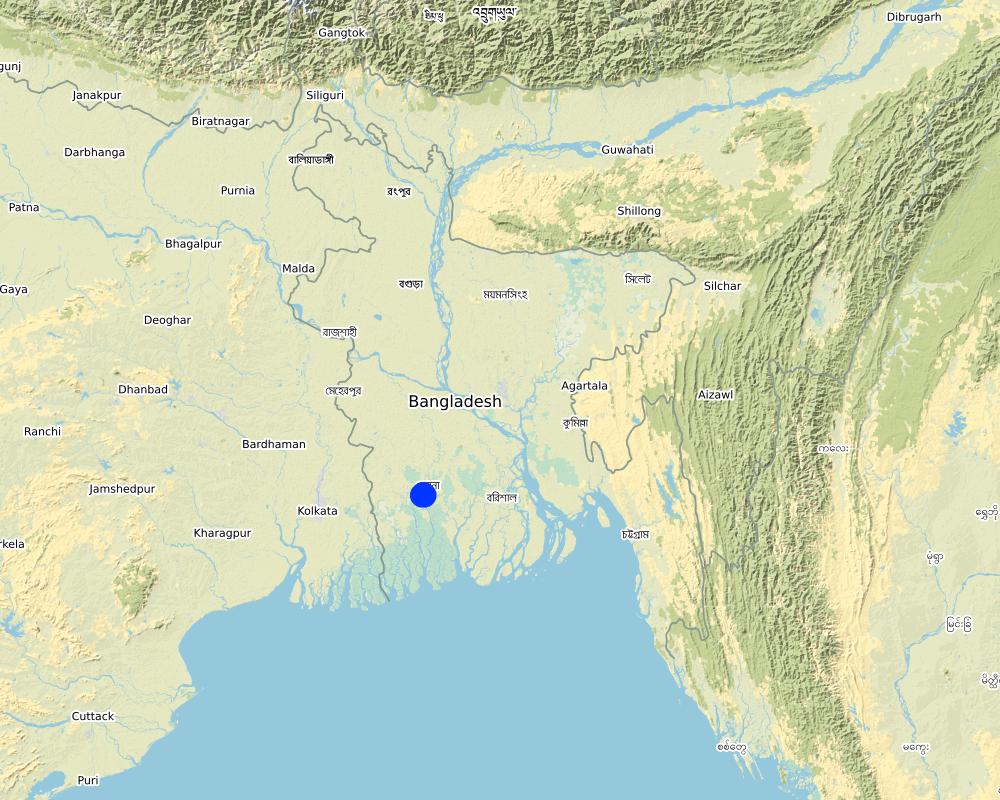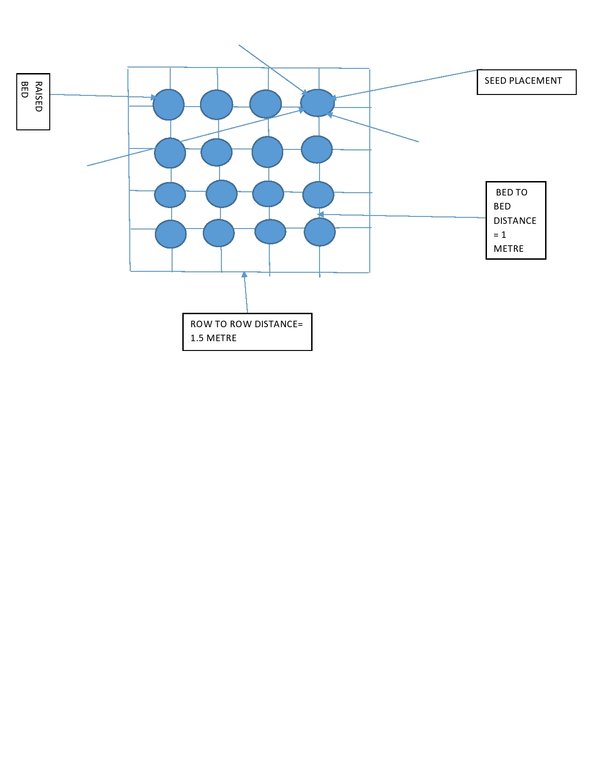Pitcher irrigation for the management of moderately saline soils [ប្រទេសបង់ក្លាដែស]
- ការបង្កើត៖
- បច្ចុប្បន្នភាព
- អ្នកចងក្រង៖ Md Babul Hossain
- អ្នកកែសម្រួល៖ –
- អ្នកត្រួតពិនិត្យ Udo Höggel
Kalash shesh podhothi
technologies_4112 - ប្រទេសបង់ក្លាដែស
ពិនិត្យមើលគ្រប់ផ្នែក
ពង្រីកមើលទាំងអស់ បង្រួមទាំងអស់1. ព័ត៌មានទូទៅ
1.2 ព័ត៌មានលម្អិតពីបុគ្គលសំខាន់ៗ និងស្ថាប័នដែលចូលរួមក្នុងការវាយតម្លៃ និងចងក្រងឯកសារនៃបច្ចេកទេស
អ្នកជំនាញឯកទេស SLM:
Biswas Sachindranath
+8801718691666
Soil Resource Development Institute
Principal scientific officer, Soil Resource Development Institute, Regional office, khulna
ប្រទេសបង់ក្លាដែស
អ្នកជំនាញឯកទេស SLM:
Biswas Amarendra Nath
+8801718732843
Soil Resource Development Institute
Senior Scientific Officer, Soil Resource Development Institute, Regional Office, Khulna.
ប្រទេសបង់ក្លាដែស
co-compiler:
Zahid Ameer M.D.
8801552409934
zahidsrdi@yahoo.com
Soil Resource Development Institute
Soil Resource Development Institute, Head Office, Farmgate,Dhaka-1215
ប្រទេសបង់ក្លាដែស
ឈ្មោះគម្រោងដែលបានចងក្រងឯកសារ/ វាយតម្លៃលើបច្ចេកទេស (បើទាក់ទង)
Decision Support for Mainstreaming and Scaling out Sustainable Land Management (GEF-FAO / DS-SLM)ឈ្មោះអង្គភាពមួយ (ច្រើន) ដែលបានចងក្រងឯកសារ/ វាយតម្លៃបច្ចេកទេស (បើទាក់ទង)
Soil Resource Development Institute (SRDI) (Soil Resource Development Institute (SRDI)) - ប្រទេសបង់ក្លាដែស1.3 លក្ខខណ្ឌទាក់ទងទៅនឹងការប្រើប្រាស់ទិន្នន័យដែលបានចងក្រងតាមរយៈ វ៉ូខេត
តើពេលណាដែលទិន្នន័យបានចងក្រង (នៅទីវាល)?
14/2/2017
អ្នកចងក្រង និង(បុគ្គលសំខាន់ៗ)យល់ព្រមទទួលយកនូវលក្ខខណ្ឌនានាទាក់ទងទៅនឹងការប្រើប្រាស់ទិន្នន័យដែលបានចងក្រងតាមរយៈវ៉ូខេត:
បាទ/ចា៎
1.4 សេចក្តីប្រកាសស្តីពីចីរភាពនៃការពណ៌នាពីបច្ចេកទេស
តើបច្ចេកទេសដែលបានពណ៌នានេះមានបញ្ហាដែលផ្តោតលើការធ្លាក់ចុះគុណភាពដី, បើដូច្នេះវាមិនអាចត្រូវបានប្រកាសថាជាបច្ចេកទេសនៃការគ្រប់គ្រងប្រកបដោយចីរភាពទេ?
ទេ
មតិយោបល់:
Pitcher irrigation technique is very effective to check the salinity development on the soil surface through capillary pores in dry season ( November to May ) in salt affected coastal area of Bangladesh.
2. ការពណ៌នាពីបច្ចេកទេស SLM
2.1 ការពណ៌នាដោយសង្ខេបពីបច្ចេកទេស
និយមន័យបច្ចេកទេស:
The technology is called pitcher irrigation technology because irrigation water is provided from an earthen pitcher which has several small holes on its bottom. The earthen pitcher is placed on a raised bed which is filled with fresh irrigation water having several pores on its bottom. Then jute fibres are entered into the pores.Then, the pitchers are filled with fresh irrigation water to reduce soil salinity, increase irrigation water use efficiency, increase land cover as well as soil productivity. The technology is popular in case of vegetable cultivation in moderately salt affected area in Bangladesh.
2.2 ការពណ៌នាលម្អិតពីបច្ចេកទេស
ការពណ៌នា:
Agriculture is a major sector of Bangladesh's economy and the coastal area of Bangladesh is suitable for growing rice. More than 30% of the cultivable land in Bangladesh is in the coastal area. Out of 2.86 million hectares of coastal and off-shore lands, about 1.056 million ha of arable lands are affected by varying degrees of salinity. Farmers mostly cultivate low yielding, traditional rice varieties during wet season. Most of the land remain fallow in the dry season (January- May) because of soil salinity, lack of good quality irrigation water and late draining condition ( Karim et al., 1990; Mondal,1997 and SRDI, 2001). Crop production of the salt affected areas in the coastal regions differs considerably from non saline areas. Because of salinity, a special environmental and hydrological situation exists, that restricts the normal crop production throughout the year. In the recent past, with the changing degree of salinity of some areas due to further intrusion of saline water from the sea, normal crop production becomes very risky. Crop yields, cropping intensity, production levels and people’s quality of livelihood are much lower than that in other parts of the country, which have enjoyed the fruits of modern agriculture technologies based on high-yielding varieties, improved fertilizer and water management and improved pest and disease control measures ( BBS, 2001). At the same time food demand in the area is increasing with the steady increase in human population.
In this circumstances, Salinity Management and Research Centre( SMRC) of the Soil Resource Development Institute, located in Batiaghata, Khulna has developed some technologies which can reduce soil salinity, increase irrigation water use efficiency, increase land vegetative cover as well as soil productivity. Now the pitcher irrigation technology is popular in Khulna, Satkhira and Bagherhat districts of Bangladesh.
In this irrigation method, at first, several pores ( 2.2 mm in diameter) are made on the bottom of an earthen pitcher. Then, some jute fibres ( 30 cm long) are entered into the holes keeping 20 cm outside of the pitcher. After that, the pitcher is placed on a raised bed and fill it up with fresh water. Some seed / seedlings (Lagenaria siceraria, Solanum spp, Abelmoschus esculentus, Cucumis sativus, Benincasa hispida) are sown on different corners of the raised bed. It is done before setting the pitcher on the bed. Then water comes out / seeps very slowly through the fibres. It has several benefits as concerns the scientific point of view. First of all, it reduces irrigation water loss at least 70% as compared to flood irrigation due to reduced run off and evaporation . It supplies irrigation water continuously at the surface of the plant bed and rootzone of the crops. The pitcher needs to be refilled at 15 days interval. As a result, the salt movement is hampered / hindered to rise to the surface through capillary pores because of continuous drip irrigation. So, salinity level in the soil doesn't increase throughout the cropping season. Secondly, this technology enhances the seed germination percentage and creates a favourable environment for uptaking soil nutrient by plants and increasing the crop yield.
The farmers responded quickly to adopt the technology, because thousand hectares of land remain fallow in coastal areas in the dry season. During this period, there are two major problems: soil salinity, water salinity and scarcity of suitable irrigation water. The pitcher irrigation technology is playing an important role to reduce soil salinity as well as increasing the efficiency of irrigation and increasing crop yield.
2.3 រូបភាពនៃបច្ចេកទេស
2.5 ប្រទេស/តំបន់/ទីតាំងកន្លែង ដែលបច្ចេកទេសត្រូវបានអនុវត្ត និងបានគ្រប់ដណ្តប់ដោយការវាយតម្លៃនេះ
ប្រទេស:
ប្រទេសបង់ក្លាដែស
តំបន់/រដ្ឋ/ខេត្ត:
Khulna region
បញ្ជាក់បន្ថែមពីលក្ខណៈនៃទីតាំង:
The region consists of Bagerhat, Satkhira, Khulna, Jessore and Kustia districts.
Map
×2.6 កាលបរិច្ឆេទនៃការអនុវត្ត
ប្រសិនបើមិនច្បាស់ឆ្នាំ សូមបញ្ជាក់កាលបរិច្ឆេទដែលប្រហាក់ប្រហែល:
- តិចជាង 10ឆ្នាំមុន (ថ្មី)
2.7 ការណែនាំពីបច្ចេកទេស
សូមបញ្ជាក់តើបច្ចេកទេសត្រូវបានណែនាំឱ្យអនុវត្តដោយរបៀបណា:
- ពេលកំពុងពិសោធន៍
3. ចំណាត់ថ្នាក់នៃបច្ចេកទេស SLM
3.1 គោលបំណងចម្បង (១ ឬច្រើន) នៃបច្ចេកទេសនេះ
- ធ្វើឱ្យប្រសើរឡើងនូវផលិតកម្ម
- កាត់បន្ថយ, បង្ការ, ស្តារឡើងវិញនូវការធ្លាក់ចុះគុណភាពដី
- អភិរក្សប្រព័ន្ធអេកូឡូស៊ី
- អភិរក្ស/ធ្វើឱ្យប្រសើរឡើងជីវចម្រុះ
- overcome soil salinity
3.2 ប្រភេទដីប្រើប្រាស់មួយប្រភេទ (ច្រើនប្រភេទ) ដែលបានអនុវត្តបច្ចេកទេស

ដីដាំដំណាំ
- ដំណាំប្រចាំឆ្នាំ
ដំណាំចម្បង (ដំណាំកសិ-ឧស្សាហកម្ម និងដំណាំស្បៀង) :
Bottle gourd, sponge gourd, okra, indian spinach, cucumber, ash gourd, sweet gourd etc.
3.3 ព័ត៌មានបន្ថែមអំពីអ្នកប្រើប្រាស់ដី
ការផ្គត់ផ្គង់ទឹកនៅកន្លែងអនុវត្តបច្ចេកទេស:
- ទឹកភ្លៀង និងប្រព័ន្ធស្រោចស្រព
ចំនួនសារដែលដាំដំណាំក្នុងមួយឆ្នាំ:
- 2
សូមបញ្ជាក់:
Rainfed rice - vegetables
3.4 ក្រុម SLM ដែលបច្ចេកទេសស្ថិតនៅក្នុង
- ធ្វើឱ្យប្រសើរឡើងគម្របដី/ ដំណាំគម្របដី
- ការគ្រប់គ្រងប្រព័ន្ធស្រោចស្រព (រួមទាំងការផ្គត់ផ្គង់ទឹក ប្រព័ន្ធបង្ហូរ)
- Mitigate soil salinity
3.5 ការសាយភាយនៃបច្ចេកទេស
បញ្ជាក់ពីការសាយភាយនៃបច្ចេកទេស:
- អនុវត្តនៅកន្លែងជាក់លាក់មួយ/ ប្រមូលផ្តុំនៅតំបន់តូចៗ
មតិយោបល់:
Pitcher irrigation technology is being used in moderately saline soil areas. In case of extreme salinity, it cannot reduce the salinity to an optimal level.
3.6 វិធានការ SLM ដែលបញ្ចូលនូវបច្ចេកទេស

វិធានការរចនាស័ម្ពន្ធ
- S4: កម្រិតភ្លឺ រណ្តៅ
មតិយោបល់:
Instead of flood irrigation, controlled irrigation (pitcher irrigation) has been used in coastal areas of Bangladesh to keep moderate soil salinity in check.
3.7 កំណត់ប្រភេទនៃការធ្លាក់ចុះគុណភាពដីសំខាន់ៗដែលបច្ចេកទេសនេះបានដោះស្រាយ

ការធ្លាក់ចុះសារធាតុគីមីក្នុងដី
- Cs: សារធាតុប្រៃ/អាល់កាឡាំង

ការធ្លាក់ចុះជីវសាស្ត្រនៃដី
- Bc: ការថយចុះនូវគម្របរុក្ខជាតិ
- Bh: ការបាត់បង់ទីជំរក
3.8 ការពារ កាត់បន្ថយ ឬស្តារឡើងវិញនៃការធ្លាក់ចុះគុណភាពដី
បញ្ជាក់ពីគោលដៅរបស់បច្ចេកទេស ដែលផ្តោតទៅការធ្លាក់ចុះគុណភាពដី:
- ការកាត់បន្ថយការធ្លាក់ចុះគុណភាពដី
- ការបន្ស៊ាំទៅនឹងការធ្លាក់ចុះគុណភាពដី
4. បច្ចេកទេសជាក់លាក់ សកម្មភាពអនុវត្ត ធាតុចូល និងថ្លៃដើម
4.1 គំនូសបច្ចេកទេសនៃបច្ចេកទេសនេះ
4.2 លក្ខណៈពិសេសនៃបច្ចេកទេស/ ពណ៌នាពីគំនូរបច្ចេកទេស
Common sized pitchers (15 litre) have to be collected. At their bottom, 5-6 holes will be made in the form of ballpoint pens (circumference at approximately 2.2 cm). Thereafter, strings of jute fibre (30 centimetre long) will be inserted into the holes. After that, the earthen pitcher will be placed in the raised soil bed (diameter 40 centimetres) in such a way that the holes and jute fibers remain in contact with the soil. Thereafter, 4 seeds should be sown on the 4 corners of the raised bed . The seeds so sown will germinate easily due to moist soil. The jute attached to the holes of the pit will allow water to infiltrate the soil so enable water supply at the root zone of the plants. The mada (raised soil bed) will always be wet. As a result, salt water from the ground level will not come up to the soil surface, thereby preventing the soil salinity in the mada (raised soil bed) area from increasing. Besides, the plants will be able to get adequate water and plant nutrients. Majaor elements of the technology are:
A large size pitcher( 15 litre water holding capacity)
5-6 pores of approx. 2.2 cm diameter are drilled into the bottom of the pitcher
Jute fibres of 30 cm length
Pitcher placed in the middle of the bed (Mada)
4 seeds are sown in the 4 corners of the bed
Salinity reduces: 2.0-2.5 dS/metre
Water requirement: 3-4 filled pitcher amount to complete a crop( Vegetable) life cycle. The irrigation water will be used only in the raised soil bed not in the whole field.
4.3 ព័ត៌មានទូទៅដែលពាក់ព័ន្ធនឹងការគណនាធាតុចូល និងថ្លៃដើម
កំណត់របៀបនៃការគណនាថ្លៃដើម និងធាតុចូល:
- ក្នុងតំបន់អនុវត្តបច្ចេកទេស
កំណត់ទំហំ និងឯកត្តាផ្ទៃដី:
1 bigha
បើសិនប្រើឯកតាតាមផ្ទៃដីក្នុងមូលដ្ឋាន សូមបញ្ជាក់ពីខ្ជាតប្តូរទៅជាហិកតា:
0.134 hectare
ផ្សេងៗ/ រូបិយប័ណ្ណជាតិ (បញ្ជាក់):
Taka (tk)
កំណត់អត្រាប្តូរប្រាក់ពីដុល្លាទៅរូបិយប័ណ្ណតំបន់ (បើទាក់ទង)៖ 1 ដុល្លារ =:
82,0
កំណត់ថ្លៃឈ្នួលជាមធ្យមនៃការជួលកម្លាំងពលកម្មក្នុងមួយថ្ងៃ:
500 Taka
4.4 សកម្មភាពបង្កើត
| សកម្មភាព | ប្រភេទវិធានការ | ពេលវេលា | |
|---|---|---|---|
| 1. | Land preparation | ក្សេត្រសាស្ត្រ | November |
| 2. | Raised bed preparation | ក្សេត្រសាស្ត្រ | November |
| 3. | Earthen pitcher collection | ការគ្រប់គ្រង | December |
| 4. | Jute fibre collection | ផ្សេងៗ | December |
| 5. | Making pore on the bottom of the pitcher | ការគ្រប់គ្រង | December |
| 6. | Filling the pitchers with irrigation water | ផ្សេងៗ | January |
| 7. | Placing the pitchers on the beds | ការគ្រប់គ្រង | January |
| 8. | Seed sown on the bed | ក្សេត្រសាស្ត្រ | January |
មតិយោបល់:
8 hours labour cost equals to 1 day labour
4.5 ថ្លៃដើម និងធាតុចូលដែលត្រូវការសម្រាប់ការបង្កើតបច្ចេកទេស
| បញ្ជាក់ពីធាតុចូល | ឯកតា | បរិមាណ | ថ្លៃដើមក្នុងមួយឯកតា | ថ្លៃធាតុចូលសរុប | % នៃថ្លៃដើមដែលចំណាយដោយអ្នកប្រើប្រាស់ដី | |
|---|---|---|---|---|---|---|
| កម្លាំងពលកម្ម | Land preparation | persons/day | 5,0 | 500,0 | 2500,0 | 100,0 |
| កម្លាំងពលកម្ម | Raised bed preparation | persons/day | 7,0 | 500,0 | 3500,0 | 100,0 |
| កម្លាំងពលកម្ម | Earthen pitcher collection | persons/day | 2,0 | 500,0 | 1000,0 | 100,0 |
| កម្លាំងពលកម្ម | Jute fibre collection | persons/day | 2,0 | 500,0 | 1000,0 | 100,0 |
| សម្ភារៈ | Making pores on the bottom of the pitcher | persons/day | 5,0 | 500,0 | 2500,0 | 100,0 |
| សម្ភារៈ | Filling pitcher with irrigation water | persons/day | 5,0 | 500,0 | 2500,0 | 100,0 |
| សម្ភារៈ | Placing pitcher on the bed | persons/day | 5,0 | 500,0 | 2500,0 | 100,0 |
| សម្ភារៈ | Seed sown on the bed | persons/day | 1,0 | 500,0 | 500,0 | 100,0 |
| សម្ភារៈ | Earthen pot | number | 40,0 | 25,0 | 1000,0 | 100,0 |
| សម្ភារៈ | Jute fibre | kg | 2,0 | 50,0 | 100,0 | 100,0 |
| សម្ភារៈ | Drilling machine | number | 2,0 | 100,0 | 200,0 | 100,0 |
| សម្ភារៈដាំដុះ | Seed( Bottle gourd, sweet gourd, cucumber etc) | kg | 2,0 | 200,0 | 400,0 | 100,0 |
| ជី និងសារធាតុពុល | Urea( Nitrogen) | kg | 15,0 | 16,0 | 240,0 | 100,0 |
| ជី និងសារធាតុពុល | TSP( Triple super phosphate) | kg | 6,0 | 22,0 | 132,0 | 100,0 |
| ជី និងសារធាតុពុល | MOP( Muriate of potash) | kg | 10,0 | 30,0 | 300,0 | 100,0 |
| ជី និងសារធាតុពុល | Gypsum( Sulphur) | kg | 35,0 | 3,0 | 105,0 | 100,0 |
| ផ្សេងៗ | Irrigation water cost | Tk/bigha | 3000,0 | |||
| ថ្លៃដើមសរុបក្នុងការបង្កើតបច្ចេកទេស | 18477,0 | |||||
4.6 សកម្មភាពថែទាំ
| សកម្មភាព | ប្រភេទវិធានការ | ពេលវេលា/ ភាពញឹកញាប់ | |
|---|---|---|---|
| 1. | Loosening the soil by labourer with spade | ក្សេត្រសាស្ត្រ | March |
| 2. | Putting soil on the bed by labourer with spade | ក្សេត្រសាស្ត្រ | March |
4.7 កំណត់ថ្លៃដើមសម្រាប់ការថែទាំ/ សកម្មភាពរបស់បច្ចេកទេស (ក្នុងរយៈពេលមួយឆ្នាំ)
| បញ្ជាក់ពីធាតុចូល | ឯកតា | បរិមាណ | ថ្លៃដើមក្នុងមួយឯកតា | ថ្លៃធាតុចូលសរុប | % នៃថ្លៃដើមដែលចំណាយដោយអ្នកប្រើប្រាស់ដី | |
|---|---|---|---|---|---|---|
| កម្លាំងពលកម្ម | Loosening the soil by labourer with spade | persons/day | 5,0 | 500,0 | 2500,0 | 100,0 |
| កម្លាំងពលកម្ម | Putting soil on the bed by labourer with spade | persons/day | 6,0 | 500,0 | 3000,0 | 100,0 |
| ថ្លៃដើមសរុបសម្រាប់ការថែទាំដំណាំតាមបច្ចេកទេស | 5500,0 | |||||
4.8 កត្តាសំខាន់បំផុតដែលមានឥទ្ធិពលដល់ការចំណាយ
ពណ៌នាពីកត្តាប៉ះពាល់ចម្បងៗទៅលើថ្លៃដើម:
Labour costs affect the total technology cost. Labour scarcity is severe in coastal areas of Bangladesh.
5. លក្ខណៈបរិស្ថានធម្មជាតិ និងមនុស្ស
5.1 អាកាសធាតុ
បរិមាណទឹកភ្លៀងប្រចាំឆ្នាំ
- < 250 មម
- 251-500 មម
- 501-750 មម
- 751-1,000 មម
- 1,001-1,500 មម
- 1,501-2,000 មម
- 2,001-3,000 មម
- 3,001-4,000 មម
- > 4,000 មម
កំណត់បរិមាណទឹកភ្លៀង (បើដឹង) ជា មីលីម៉ែត្រ:
2500,00
លក្ខណៈពិសេស/ មតិយោបល់លើរដូវភ្លៀង:
Monsoon rainfall (June to October), in winter season very little rain (October to March).
បញ្ជាក់ឈ្មោះឯកសារយោងនៃស្ថានីយឧតុនិយម:
Khulna
តំបន់កសិអាកាសធាតុ
- មានភ្លៀងមធ្យម
5.2 សណ្ឋានដី
ជម្រាលជាមធ្យម:
- រាបស្មើ (0-2%)
- ជម្រាលតិចតួច (3-5%)
- មធ្យម (6-10%)
- ជម្រាលខ្ពស់បន្តិច (11-15%)
- ទីទួល (16-30%)
- ទីទួលចោត (31-60%)
- ទីទួលចោតខ្លាំង (>60%)
ទម្រង់ដី:
- ខ្ពង់រាប
- កំពូលភ្នំ
- ជម្រាលភ្នំ
- ជម្រាលទួល
- ជម្រាលជើងភ្នំ
- បាតជ្រលងភ្នំ
តំបន់តាមរយៈកម្ពស់ :
- 0-100 ម
- 101-500 ម
- 501-1,000 ម
- 1,001-1,500 ម
- 1,501-2,000 ម
- 2,001-2,500 ម
- 2,501-3,000 ម
- 3,001-4,000 ម
- > 4,000 ម
បញ្ជាក់ថាតើបច្ចេកទេសនេះត្រូវបានអនុវត្តន៍នៅក្នុង:
- មិនពាក់ព័ន្ធទាំងអស់
5.3 ដី
ជម្រៅដីជាមធ្យម:
- រាក់ខ្លាំង (0-20 សម)
- រាក់ (21-50 សម)
- មធ្យម (51-80 សម)
- ជ្រៅ (81-120 សម)
- ជ្រៅខ្លាំង (> 120 សម)
វាយនភាពដី (ស្រទាប់លើ):
- ម៉ត់/ ធ្ងន់ (ឥដ្ឋ)
វាយនភាពដី (> 20 សម ស្រទាប់ក្នុង):
- ម៉ត់/ ធ្ងន់ (ឥដ្ឋ)
សារធាតុសរីរាង្គនៅស្រទាប់ដីខាងលើ:
- ទាប (<1%)
5.4 ទឹកដែលអាចទាញមកប្រើប្រាស់បាន និងគុណភាពទឹក
នីវ៉ូទឹកក្រោមដី:
< 5 ម
ទឹកលើដីដែលអាចទាញយកប្រើប្រាស់បាន:
កម្រិតមធ្យម
គុណភាពទឹក (មិនបានធ្វើប្រត្តិកម្ម):
ទឹកមិនអាចប្រើប្រាស់បាន
តើមានបញ្ហាភាពទឹកប្រៃហូរចូលមកដែរឬទេ?
បាទ/ចា៎
សូមបញ្ជាក់:
In dry winter season, the water as well as soil is moderately to highly saline. In the rainy season, salt washed out by heavy rain and flood water.
តើទឹកជំនន់កំពុងកើតមាននៅតំបន់នេះដែររឺទេ?
បាទ/ចា៎
ភាពទៀងទាត់:
ញឹកញាប់
5.5 ជីវៈចម្រុះ
ភាពសម្បូរបែបនៃប្រភេទ:
- ទាប
ភាពសម្បូរបែបនៃទីជម្រក:
- ទាប
5.6 លក្ខណៈនៃអ្នកប្រើប្រាស់ដីដែលអនុវត្តបច្ចេកទេស
នៅមួយកន្លែង ឬពនេចរ :
- នៅមួយកន្លែង
ទីផ្សារនៃប្រព័ន្ធផលិតកម្ម:
- សម្រាប់ហូបក្នុងគ្រួសារ (ផ្គត់ផ្គង់ខ្លួនឯង)
ចំណូលក្រៅកសិកម្ម:
- តិចជាង 10% នៃចំណូល
កម្រិតជីវភាព:
- មិនល្អ
ឯកជន ឬក្រុម:
- ធ្វើខ្លួនឯង/ គ្រួសារ
កម្រិតប្រើប្រាស់គ្រឿងយន្ត:
- ប្រើកម្លាំងពលកម្ម
- គ្រឿងយន្ត/ ម៉ាស៊ីន
យេនឌ័រ:
- ស្ត្រី
- បុរស
អាយុរបស់អ្នកប្រើប្រាស់ដី:
- យុវវ័យ
- វ័យកណ្តាល
5.7 ទំហំផ្ទៃដីជាមធ្យមនៃដីផ្ទាល់ខ្លួន ឬជួលគេដែលបានអនុវត្តបច្ចេកទេស
- < 0.5 ហិកតា
- 0.5-1 ហិកតា
- 1-2 ហិកតា
- 2-5 ហិកតា
- 5-15 ហិកតា
- 15-50 ហិកតា
- 50-100 ហិកតា
- 100-500 ហិកតា
- 500-1,000 ហិកតា
- 1,000-10,000 ហិកតា
- > 10,000 ហិកតា
តើផ្ទៃដីនេះចាត់ទុកជាទំហំកម្រិតណាដែរ ខ្នាតតូច មធ្យម ឬខ្នាតធំ (ធៀបនឹងបរិបទតំបន់)?
- ខ្នាតតូច
5.8 ភាពជាម្ចាស់ដី កម្មសិទ្ធប្រើប្រាស់ដី និងកម្មសិទ្ធប្រើប្រាស់ទឹក
ភាពជាម្ចាស់ដី:
- ឯកជន មិនមានកម្មសិទ្ធ
- ឯកជន មានកម្មសិទ្ធ
កម្មសិទ្ធិប្រើប្រាស់ដី:
- ឯកជន
កម្មសិទ្ធប្រើប្រាស់ទឹក:
- អាស្រ័យផលសេរី (មិនមានការកំណត់)
5.9 ការប្រើប្រាស់សេវាកម្ម និងហេដ្ឋារចនាសម្ព័ន្ធ
សុខភាព:
- មិនល្អ
- មធ្យម
- ល្អ
ការអប់រំ:
- មិនល្អ
- មធ្យម
- ល្អ
ជំនួយបច្ចេកទេស:
- មិនល្អ
- មធ្យម
- ល្អ
ការងារ (ឧ. ការងារក្រៅកសិដ្ឋាន):
- មិនល្អ
- មធ្យម
- ល្អ
ទីផ្សារ:
- មិនល្អ
- មធ្យម
- ល្អ
ថាមពល:
- មិនល្អ
- មធ្យម
- ល្អ
ផ្លូវ និងការដឹកជញ្ជូន:
- មិនល្អ
- មធ្យម
- ល្អ
ទឹកផឹក និងអនាម័យ:
- មិនល្អ
- មធ្យម
- ល្អ
សេវាកម្មហិរញ្ញវត្ថុ:
- មិនល្អ
- មធ្យម
- ល្អ
6. ផលប៉ះពាល់ និងការសន្និដ្ឋាន
6.1 ផលប៉ះពាល់ក្នុងបរិវេណអនុវត្តបច្ចេកទេសដែលកើតមាន
ផលប៉ះពាល់លើសេដ្ឋកិច្ចសង្គម
ផលិតផល
ផលិតកម្មដំណាំ
មតិយោបល់/ ការបញ្ជាក់:
.
គុណភាពដំណាំ
ហានិភ័យនៃភាពបរាជ័យរបស់ផលិតកម្ម
ផ្ទៃដីផលិតកម្ម
មតិយោបល់/ ការបញ្ជាក់:
As the technology has been proved promising for salt affected soil management, its usage has spreaded for crop production in large area.
ការគ្រប់គ្រងដី
ចំណូល និងថ្លៃដើម
ការចំណាយលើធាតុចូលកសិកម្ម
ចំណូលក្នុងកសិដ្ឋាន
មតិយោបល់/ ការបញ្ជាក់:
Agricultural inputs decreased
ភាពសម្បូរបែបប្រភពប្រាក់ចំណូល
មតិយោបល់/ ការបញ្ជាក់:
Production of different vegetables increased. So, the produces are being used in agro based industries for different purposes.
ភាពខុសគ្នាផ្នែកសេដ្ឋកិច្ច
មតិយោបល់/ ការបញ្ជាក់:
Different classes of people are now being involved in vegetable production in saline areas and the poor and unemployed people are earning money by selling agricultural products.
បន្ទុកការងារ
មតិយោបល់/ ការបញ្ជាក់:
As the technology requires so many people for pitcher setting on the bed, so workload will be increased.
ផលប៉ះពាល់ទៅលើវប្បធម៌សង្គម
សន្តិសុខស្បៀង/ ភាពគ្រប់គ្រាន់ខ្លួនឯង
ស្ថានភាពសុខភាព
កម្មសិទ្ធដីប្រើប្រាស់/ ទឹក
ចំណេះដឹង SLM / ការធ្លាក់ចុះគុណភាពដី
ផលប៉ះពាល់ទៅលើអេកូឡូស៊ី
វដ្តទឹក/លំហូរ
បរិមាណទឹក
លំហូរទឹកលើផ្ទៃដី
ប្រព័ន្ធបង្ហូរទឹក
នីវ៉ូទឹកក្រោមដី/ ដង្ហើមទឹក
រំហួត
មតិយោបល់/ ការបញ្ជាក់:
Evaporation decreases due to drip irrigation comparison to flood irrigation.
ដី
សំណើមដី
គម្របដី
ការបាត់បង់ដី
ការកើនឡើងដី
ដីប្រេះ
មតិយោបល់/ ការបញ្ជាក់:
Due to loosening of raised soil beds.
ដីហាប់
វដ្តនៃសារធាតុចិញ្ចឹម/ការទទួលបាន
ភាពប្រៃ
សារធាតុសរីរាង្គដី/ការបូនក្រោមដី
ជាតិអាស៊ីត
មតិយោបល់/ ការបញ្ជាក់:
As the soil will be kept moist during crop production, soil acidity will be reduced.
ជីវចម្រុះ៖ ដំណាំ, សត្វ
ដំណាំគម្រប
ជីវម៉ាស/ កាបូនលើដី
ភាពសម្បូរបែបនៃរុក្ខជាតិ
ភាពសម្បូរបែបនៃសត្វ
ប្រភេទសត្វមានប្រយោជន៍
ភាពសម្បូរបែបនៃទីជំរក
ការគ្រប់គ្រងកត្តាចង្រៃ/ ជំងឺ
ការកាត់បន្ថយហានិភ័យនៃគ្រោះមហន្តរាយ និងគ្រោះអាកាសធាតុ
ផលប៉ះពាល់នៃគ្រោះរាំងស្ងួត
ការបំភាយនៃកាបូន និងឧស្ម័នផ្ទះកញ្ចក់
អាកាសធាតុ
6.2 ផលប៉ះពាល់ក្រៅបរិវេណអនុវត្តបច្ចេកទេសដែលកើតមាន
ទឹកដែលអាចទាញមកប្រើប្រាស់បាន
ទឹកក្រោមដី/ ការបំពុលទឹកទន្លេ
ផលប៉ះពាល់នៃឧស្ម័នផ្ទះកញ្ចក់
មតិយោបល់/ ការបញ្ជាក់:
Cropping intensity has increased due to the technology adoption and the crops are absorbing more CO2.
6.3 ភាពប្រឈម និងភាពរួសនៃបច្ចេកទេសទៅនឹងការប្រែប្រួលអាកាសធាតុ និងគ្រោះអាកាសធាតុ/ គ្រោះមហន្តរាយ (ដែលដឹងដោយអ្នកប្រើប្រាស់ដី)
ការប្រែប្រួលអាកាសធាតុ
ការប្រែប្រួលអាកាសធាតុ
| រដូវកាល | ប្រភេទនៃការប្រែប្រួលអាកាសធាតុ/ព្រឹត្តិការណ៍ | លក្ខណៈឆ្លើយតបនៃបច្ចេកទេសទៅនឹងការប្រែប្រួលអាកាសធាតុ | |
|---|---|---|---|
| សីតុណ្ហភាពប្រចាំឆ្នាំ | កើនឡើង | មធ្យម | |
| សីតុណ្ហភាពប្រចាំរដូវកាល | រដូវក្តៅ | កើនឡើង | មធ្យម |
| បរិមាណទឹកភ្លៀងប្រចាំឆ្នាំ | ថយចុះ | ល្អ | |
| បរិមាណទឹកភ្លៀងប្រចាំរដូវកាល | រដូវប្រាំង | ថយចុះ | ល្អណាស់ |
គ្រោះអាកាសធាតុ (មហន្តរាយ)
គ្រោះមហន្តរាយធម្មជាតិ
| លក្ខណៈឆ្លើយតបនៃបច្ចេកទេសទៅនឹងការប្រែប្រួលអាកាសធាតុ | |
|---|---|
| ព្យុះតំបន់ត្រូពិច | ល្អ |
| ព្យុះរន្ទះតាមតំបន់ | មិនស្គាល់ |
គ្រោះមហន្តរាយអាកាសធាតុ
| លក្ខណៈឆ្លើយតបនៃបច្ចេកទេសទៅនឹងការប្រែប្រួលអាកាសធាតុ | |
|---|---|
| រាំងស្ងួត | ល្អ |
គ្រោះមហន្តរាយទឹក
| លក្ខណៈឆ្លើយតបនៃបច្ចេកទេសទៅនឹងការប្រែប្រួលអាកាសធាតុ | |
|---|---|
| ទឹកជំនន់ទូទៅ (ទន្លេ) | ល្អ |
| ទឹកជំនន់/ព្យុះកើនឡើងតាមតំបន់ឆ្នេរ | មធ្យម |
គ្រោះមហន្តរាយជីវៈសាស្ត្រ
| លក្ខណៈឆ្លើយតបនៃបច្ចេកទេសទៅនឹងការប្រែប្រួលអាកាសធាតុ | |
|---|---|
| ការមានបញ្ហាសត្វល្អិត/ដង្កូវ | ល្អ |
មតិយោបល់:
As the beds under the technology is a little bit raised from the level ground and the agronomic practices are more intensive than the traditional cultivation system, so insect/pest infestation is below economic injury level.
6.4 ការវិភាគថ្លៃដើម និងអត្ថប្រយោជន៍
តើផលចំណេញ និងថ្លៃដើមត្រូវបានប្រៀបធៀបគ្នាយ៉ាងដូចម្តេច (ទស្សនៈរបស់អ្នកប្រើប្រាស់ដី)?
រយៈពេលខ្លី:
វិជ្ជមាន
រយៈពេលវែង:
វិជ្ជមាន
តើផលចំណេញ និងការថែទាំ/ ជួសជុលត្រូវបានប្រៀបធៀបគ្នាយ៉ាងដូចម្តេច (ទស្សនៈរបស់អ្នកប្រើប្រាស់ដី)?
រយៈពេលខ្លី:
វិជ្ជមាន
រយៈពេលវែង:
វិជ្ជមានខ្លាំង
6.5 ការទទួលយកបច្ចេកទេស
- 10-50%
ក្នុងចំណោមគ្រួសារទាំងអស់ដែលអនុវត្តបច្ចេកទេស តើមានប៉ុន្មានគ្រួសារដែលចង់ធ្វើដោយខ្លួនឯង ដោយមិនទទួលបានសម្ភារៈលើកទឹកចិត្ត/ប្រាក់ឧបត្ថម្ភ?:
- 50-90%
6.6 ការបន្សុំា
តើថ្មីៗនេះ បច្ចេកទេសនេះត្រូវបានកែតម្រូវដើម្បីបន្ស៊ាំទៅនឹងស្ថានភាពប្រែប្រួលដែរឬទេ?
ទេ
6.7 ភាពខ្លាំង/ គុណសម្បត្តិ/ ឱកាសនៃបច្ចេកទេស
| ភាពខ្លាំង/ គុណសម្បត្តិ/ ឱកាសនៅកន្លែងរបស់អ្នកប្រើប្រាស់ដី |
|---|
| Increase crop production. Due to soil salinity the crop yield was very poor before adopting the technology. |
| Reduces soil salinity. The water enters into the soil through jute fibre , as a result, salt cannot come into soil surface through capillary movement. |
| Decrease cost of production. The whole field is not irrigated, instead the raised soil bed is irrigated with pitcher water. So, labour cost reduces. |
| Less irrigation water use. Water of 3-4 pitcher can complete a vegetable's life cycle. |
| ភាពខ្លាំង/ គុណសម្បត្តិ/ ឱកាស ទស្សនៈរបស់បុគ្គលសំខាន់ៗ |
|---|
| Increase land cover in degraded land. Reducing salinity helps to grow crops vigorously throughout the field. |
| Increase soil productivity. Through decrease of soil salinity, most of the soil nutrients become available for plants. |
| Decrease soil pollution. |
| Have opportunity to extend in moderately saline areas. |
6.8 ភាពខ្សោយ/ គុណវិបត្តិ/ ហានិភ័យនៃបច្ចេកទេស និងវិធីសាស្ត្រដោះស្រាយ
| ភាពខ្សោយ/ គុណវិបត្តិ/ ហានិភ័យ ទស្សនៈរបស់អ្នកប្រើប្រាស់ដី | តើបច្ចេកទេសទាំងនោះបានដោះស្រាយបញ្ហាដូចម្តេច? |
|---|---|
| Not suitable for large scale crop production. | Mechanization can be introduced instead of manual labour to cover large area. |
| Establishment cost is higher. | With proper agronomic practices, farmers are trying to get higher yield and they are producing high value crops like rock melon. |
| In case of high salinity, yield is not sufficient. | Adoption of the technology for long period of time, will help to decrease high salinity. |
| ភាពខ្សោយ/ គុណវិបត្តិ/ ហានិភ័យ ទស្សនៈរបស់អ្នកចងក្រងឬបុគ្គលសំខាន់ៗ | តើបច្ចេកទេសទាំងនោះបានដោះស្រាយបញ្ហាដូចម្តេច? |
|---|---|
| Labour scarcity. | Farm mechanization is badly in need. |
| Establishment cost higher. | Financial assistance should be given from the Government. |
7. ឯកសារយោង និងវេបសាយ
7.1 វិធីសាស្ត្រ/ ប្រភពនៃព័ត៌មាន
- តាមការចុះទីវាល ការស្រាវជ្រាវនៅទីវាល
25
- ការសម្ភាសន៍ជាមួយអ្នកប្រើប្រាស់ដី
20
- ការសម្ភាសន៍ជាមួយអ្នកជំនាញ/ ឯកទេស
10
- ការចងក្រងពីរបាកការណ៍ និងឯកសារផ្សេងៗទៀតដែលមាន
3
7.2 ឯកសារយោងដែលបានចេញផ្សាយ
ចំណងជើង អ្នកនិពន្ធ ឆ្នាំ ISBN:
Saline soils of Bangladesh, 2010
មានប្រភពមកពីណា? ថ្លៃដើមប៉ុន្មាន?
Soil Resource Development Institute, www.srdi.gov.bd. Free of cost
7.3 ចូលទៅទាញយកឯកសារដែលពាក់ព័ន្ធតាមបណ្តាញអ៊ិនធឺណែត
ចំណងជើង/ ពណ៌នា:
Causes of Salinity Intrusion in Coastal Belt of Bangladesh
វេបសាយ:
http://journal.sapub.org/plant
ចំណងជើង/ ពណ៌នា:
SALINITY CHANGES IN SOUTH WEST BANGLADESH AND ITS IMPACT ON RURAL LIVELIHOODS
វេបសាយ:
https://www.researchgate.net/.../264419412_Salinity_Pr... -
ចំណងជើង/ ពណ៌នា:
Environment and Livelihoods in Tropical Coastal Zones: Managing Agriculture .
វេបសាយ:
https://books.google.com.bd/books?isbn=1845931076
ការតភ្ជាប់ និងម៉ូឌុល
ពង្រីកមើលទាំងអស់ បង្រួមទាំងអស់ការតភ្ជាប់
គ្មានការតភ្ជាប់
ម៉ូឌុល
គ្មានម៉ូឌុល


